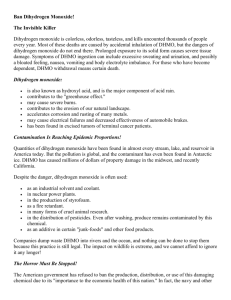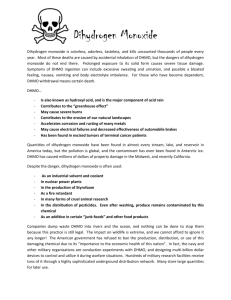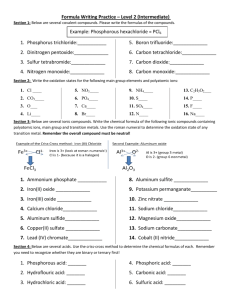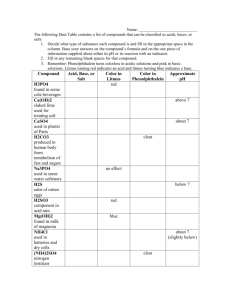Covalent Nomenclature and Acids
advertisement
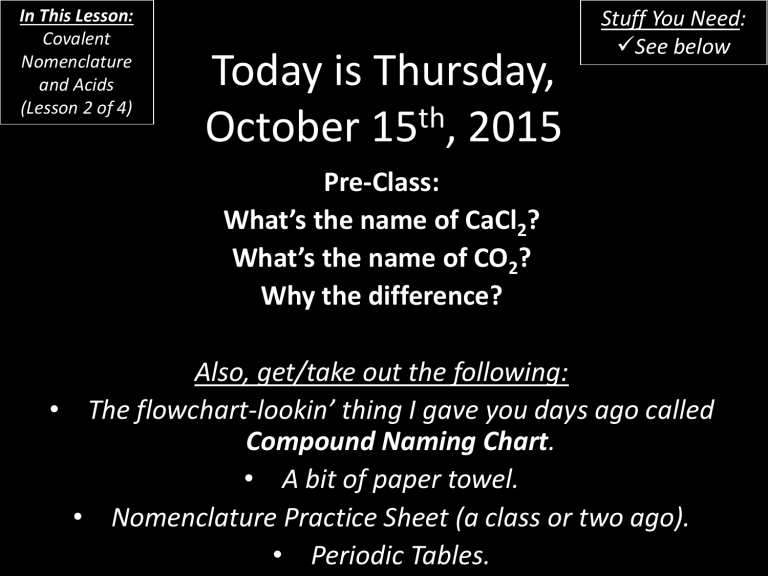
In This Lesson: Covalent Nomenclature and Acids (Lesson 2 of 4) Today is Thursday, th October 15 , 2015 Stuff You Need: See below Pre-Class: What’s the name of CaCl2? What’s the name of CO2? Why the difference? Also, get/take out the following: • The flowchart-lookin’ thing I gave you days ago called Compound Naming Chart. • A bit of paper towel. • Nomenclature Practice Sheet (a class or two ago). • Periodic Tables. Today’s Agenda • Naming acids. • Naming covalent (molecular) compounds. • PRACTICE. • Where is this in my book? – P. 268 and following… By the end of this lesson… • You should be able to name molecular compounds and acids. Practice to Start • #180 Names – 70-90 • Quiz Review Acids • We’ll learn about acids later in the year. For now, know this: – Acids are always aqueous (aq) – dissolved in water. – Most acids’ chemical formulas begin with Hydrogen (H). • Naming them follows a predictable few steps. Naming Acids • First, cover the (H) and name the anion normally. – Sulfide. • Next, use this key: Example H2 Anion Suffix Acid Name -ide Hydro___ic acid -ate ___ic acid -ite ___ous acid • Hydrosulfuric acid 2S Remembering Acid Names • “Ick, I ate it.” – __ic is the acid suffix for stuff otherwise ending in __ate. • “Ite, I oust it.” OR “Riteous” – __ous is the acid suffix for stuff otherwise ending in __ite. • You’ll have to come up with something for hydro___ic acid. I’m not creative enough. Practice • HCl – Cl- would be chloride, so it’s hydrochloric acid. • H2SO4 – SO42- would be sulfate, so it’s sulfuric acid. • HClO2 – ClO2- would be chlorite, so it’s chlorous acid. Practice • 180 Names – 141-150 And, of course, backwards… • To write an acid formula from its name, reverse the naming key. • Then, balance the charge of the anion with the appropriate number of hydrogen atoms. – Hydrogen forms a 1+ charge in acids. • Example: Nitrous Acid – Nitrous means it must have been Nitrite (NO2-) – To balance the -1 charge, use one H+ ion. – HNO2 Writing Acid Formulas • Bromic Acid – HBrO3 • Hydroiodic Acid – HI • Chlorous Acid – HClO2 • Phosphoric Acid – H3PO4 Now then… • Previously we learned about binary ionic compounds. – Compounds involving two elements bonded ionically (because of their charge) – typically a metal and a nonmetal. • Now we will learn about binary molecular compounds. – These are compounds between two nonmetals or metalloids. – Also known as binary covalent compounds. Molecular Compound Nomenclature • The first element in the formula is named first. – It keeps its original name. – If there is a subscript on it, it gets a prefix. • Don’t put “mono” in there. • The second element is named second (duh). – Use the element root name plus the –ide suffix. – Always use a prefix on the second element. • The second element is always the more electronegative one (generally closer to Fluorine). Prefixes Number Prefix 1 Mon(o)- 2 Di- 3 Tri- 4 Tetr(a)- 5 Pent(a)- 6 Hex(a)- 7 Hept(a)- 8 Oct(a)- 9 Non(a)- 10 Dec(a)- Naming Binary Compounds • P2O5 – Diphosphorous pentoxide • CO2 – Carbon dioxide • CO – Carbon monoxide • N2O – Dinitrogen monoxide Practice – Write the Name Compound Formula Compound Name N2O4 Dinitrogen tetroxide SO3 Sulfur trioxide CH6 Carbon hexahydride NO2 Nitrogen dioxide As2O5 Diarsenic pentoxide PCl3 Phosphorus trichloride CCl4 Carbon tetrachloride SeF6 Selenium hexafluoride Practice – Write the Formula Compound Formula Compound Name N2I3 Dinitrogen Triiodide P2O5 Diphosphorus pentoxide N2O Dinitrogen monoxide SiO2 Silicon dioxide CBr4 Carbon tetrabromide SO2 Sulfur dioxide PBr5 Phosphorus pentabromide [Hept(a)-] [Prefix for 7] A Quick Break • Occasionally, when it’s relevant, I try to stop and remind students of “big picture” things – important issues in our world concerning chemistry (or other stuff). • There is a simple compound out there that’s become an ecological menace. • Every creature needs some, but too much can lead to a major ecological, societal, and environmental disaster. • What chemical am I talking about? – Dihydrogen monoxide. Dihydrogen Monoxide • Dihydrogen monoxide is: – – – – – – Fatal if inhaled. Linked to the greenhouse effect. A major component of acid rain. Capable of causing severe burns. Eroding the natural landscape. Accelerating corrosion and rusting of metals. – Capable of causing electrical failures. – Found in the tumors of cancer patients. Dihydrogen Monoxide • Despite all those problems, dihydrogen monoxide is used in: – Nuclear power plants – Animal testing – Junk food additives – Pesticides – Schools (including this one) Dihydrogen Monoxide • To relate this to our current topic, please take a moment to write the formula for dihydrogen monoxide. I want you to know it when you see it: – H2O DHMO.org • Visit http://www.DHMO.org for more information. • Also, a DHMO Material Safety Data Sheet (MSDS). Practice • Nomenclature Practice Sheet – 25-42 How to Name • How do you know what naming system to use? • Use “ionic nomenclature” when: – There is a metal and a non-metal. – There are positive and negative charges. • Use “acid nomenclature” when: – H is in front of the formula, or the name has “acid.” • Use “covalent/molecular nomenclature” when: – There are two non-metals or metalloids. – The charges are all negative. Closure • Remember the gas density video from Mythbusters? – In the video, Adam says he’s using Helium (He) to make his voice higher. No compound there. – However, to make his voice lower, Adam uses Sulfur hexafluoride. What’s the formula? • SF6 Closure • Want practice? Want a way to do a flashcard review of nomenclature and polyatomic ions from your mobile device? • Download the StudyBlue app (it’s free for iPhone/iPad/Android) and follow this link: – http://s.tudy.it/twatvth – Class Code: 404963 • Alternatively, just follow it on a computer and it’ll work the same way. – Link is available on my Chemistry Links page. Closure • Nomenclature Review • This is it, folks. The last of the nomenclature. • Work on this quietly and on your own. We’ll break up the sections and score them as we go. • This is feedback for how you’re doing. – Take it personally. Nomenclature Review • Start with #1-19. – When finished, go to the lab tables and grade one another’s work. • Now do #20-34. – When finished, go to the lab tables and grade one another’s work. • Now do #35-46. – When finished, go to the lab tables and grade one another’s work. • Now do #47-56. #50 is tough. – When finished, go to the lab tables and grade one another’s work. • Now do #57-78. THIS SECTION IS LIKE YOUR QUIZ. – When finished, go to the lab tables and grade one another’s work. • Now do #79-81. – When finished, go to the lab tables and grade one another’s work.


